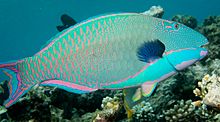Parrotfish facts for kids
Quick facts for kids Parrotfish |
|
|---|---|
 |
|
| Bicolour parrotfish | |
| Scientific classification | |
| Kingdom: | |
| Phylum: | |
| Superclass: | |
| Class: | |
| Order: | |
| Suborder: |
Labroidei
|
| Family: |
Scaridae
|
Parrotfish are amazing marine fish that live in warm, shallow parts of the ocean. You can find them in tropical and subtropical waters all over the world. They are especially common around coral reefs and seagrass beds in the Indo-Pacific region.
Scientists used to think parrotfish were their own special family called Scaridae. But now, they believe parrotfish are actually part of a bigger family. This family is the wrasses (Labridae). There are about 95 different kinds, or species, of parrotfish known today.
Parrotfish are famous for their bright, beautiful colors. Their name comes from their unique parrot-like beak. This beak is actually made from their teeth! It helps them do something very important for coral reefs.
Contents
What Makes Parrotfish Special?
Their Amazing Beak
Parrotfish have strong, fused teeth that look like a parrot's beak. They use this tough beak to scrape algae off rocks and dead coral. This helps keep the coral reefs clean and healthy.
When they eat, they also grind up bits of coral. This turns the coral into fine sand. This sand then becomes part of the beautiful white beaches you see in tropical places! This process is called bioerosion. It's how parrotfish help shape the ocean floor.
The Sleeping Sack Mystery
One of the most interesting things about parrotfish is how they sleep. At night, some parrotfish create a special "sleeping sack." This sack is made of mucus, a clear, jelly-like substance. It completely surrounds the fish.
This transparent sack helps protect the parrotfish while it sleeps. It might hide their scent from predators like sharks. In the morning, the fish leaves the sack behind. You can sometimes see these discarded sacks on the seabed.
Where Do Parrotfish Live?
Parrotfish prefer shallow, warm ocean waters. They are often found in areas with lots of coral reefs. These reefs provide them with food and shelter. They also live in seagrass beds, which are like underwater meadows. These habitats are important for their survival.
Images for kids
-
The strong beak of Bolbometopon muricatum is able to grind the sturdiest corals.
-
The bicolor parrotfish (Cetoscarus bicolor) was described by Rüppell in 1829. In 1835, he mistakenly described the terminal phase, featured on this photo, as a separate species, C. pulchellus
-
Scarus globiceps (male)
See also
 In Spanish: Pez loro para niños
In Spanish: Pez loro para niños















